Analysis of Battery Reduction for an Improved Opportunistic Wireless-Charged Electric Bus
Abstract
:1. Introduction
- How much battery energy capacity and mass of the electric bus can be reduced by using a wireless-charging system, compared with a plug-in charging system?
- How much cost can be saved due to the battery reduction?
- What are the effects of the key parameters on the battery reduction of the opportunistic wireless-charged electric bus?
2. The Battery-Reduction Models and Cost-Saving Models of the Improved Opportunistic Wireless-Charged Electric Bus
2.1. System Architecture
- The operating environment of the wireless-charged electric bus is same as that of the conventional plug-in charged electric bus mentioned above.
- The bus is also same as the conventional plug-in charged electric bus, except the battery and pickup device.
- Each station is equipped with wireless-charging infrastructure.
2.2. Battery-Reduction Models of the Improved Opportunistic Wireless-Charged Electric Bus (OWCEB)
2.2.1. The Battery-Reduction Model of the Opportunistic Stationary Wireless-Charged Electric Bus (OSWCEB)
2.2.2. The Battery-Reduction Model of the Opportunistic Hybrid Wireless-Charged Electric Bus (OHWCEB)
2.3. Cost-Saving Models
2.3.1. Production Cost Saving
2.3.2. Operation Cost Saving
2.3.3. Total Cost Saving
3. Numerical Example and Parameter Analysis
3.1. Numerical Example and Computational Results
3.2. Parameter Analysis
3.2.1. Parameter Analysis of the Opportunistic Stationary Wireless-Charging System (OSWCS)
3.2.2. Parameter Analysis of the Opportunistic Hybrid Wireless-Charging System (OHWCS)
4. Discussion
5. Conclusions
Author Contributions
Funding
Conflicts of Interest
Nomenclature
| Abbreviation | |
| EV | Electric vehicle |
| ECR | Energy consumption rate |
| OLEV | Online electric vehicle |
| OWCS | Opportunistic wireless-charging system |
| OSWCS | Opportunistic stationary wireless-charging system |
| OHWCS | Opportunistic hybrid wireless-charging system |
| OWCEB | Opportunistic wireless-charged electric bus |
| OSWCEB | Opportunistic stationary wireless-charged electric bus |
| OHWCEB | Opportunistic hybrid wireless-charged electric bus |
| PCEB | Plug-in charged electric bus |
| WPT | Wireless power transfer |
| Parameter | |
| b | Energy consumption rate of the electric bus (kWh/km) |
| Cinfra | Infrastructure cost of one bus route ($) |
| E | Battery energy capacity (kWh) |
| Ec | The energy consumed at the energy consumption rate of b in Nc cycles (kWh) |
| EE | Effective battery energy capacity (kWh) |
| EH | High limit of the battery level (kWh) |
| EH_H | High limit of the battery level of OHWCEB (kWh) |
| EH_P | High limit of the battery level of PCEB (kWh) |
| EH_S | High limit of the battery level of OSWCEB (kWh) |
| EL | Low limit of the battery level (kWh) |
| EL_H | Low limit of the battery level of OHWCEB (kWh) |
| EL_P | Low limit of the battery level of PCEB (kWh) |
| EL_S | Low limit of the battery level of OSWCEB (kWh) |
| Em,n | The amount of energy supplied by the nth stop of the mth cycle (kWh) |
| EOSWCEB | Battery energy capacity of the OSWCEB (kWh) |
| l | Length of the power track installed near each stop (m) |
| L | Length of the circular route (km) |
| ln | Length of the power track installed near the nth stop (m) |
| M | Mass of the battery (kg) |
| MBus | Mass of the plug-in charged electric bus (kg) |
| MBusi | Mass of the plug-in charged electric bus of the ith iteration (kg) |
| Mc | The battery mass corresponding to the battery energy of Ec (kg) |
| NBus | The number of electric buses operating on the route |
| Nc | The number of cycle during a day |
| Nd | The number of working days of the bus per year (d) |
| Ns | The number of stop of the round trip |
| Ny | Battery life (y) |
| OCS | Operation cost saving ($) |
| P | Charging power referring to input power of the wireless charger (kW) |
| paux | Price of per set of auxiliary equipment ($/each) |
| pb | Battery cost per unit of energy capacity ($) |
| pcoil | Price of per transmitting coil ($/each) |
| pe | Price of electricity per kilowatt-hour ($) |
| Pout | Output power of the wireless charger (kW) |
| ptrack | Price of power track per unit meter ($/m) |
| PCS | Production cost saving ($) |
| t | Average stop time at each stop (s) |
| tm,n | Charging time of the nth stop of the mth cycle (s) |
| TCS | Total cost saving ($) |
| v | Average speed of the OHWCEB passing through power track in each cycle (km/h) |
| vm,n | Average speed of OHWCEB passing through the nth power track in the mth cycle (km/h) |
| α | Battery gravimetric energy density (kWh/kg) |
| β | Proportion coefficient between b and MBus |
| λ | Limit parameter of the battery level equal to the difference between λH and λL |
| λH | Upper limit coefficient set to maximize the battery life |
| λL | Lower limit coefficients set to maximize the battery life |
| η | Efficiency of the wireless charger (%) |
| ηd | Efficiency of the dynamic wireless-charging system (%) |
| ηs | Efficiency of the stationary wireless-charging system (%) |
| Δbi | Variation of energy consumption rate of the ith iteration (kWh/km) |
| ΔEECR | Battery energy capacity reduction contributed by the reduction of ECR (kWh) |
| ΔEECR_lifetime | Energy reduction due to the reduction of ECR during the lifetime of the battery (kWh) |
| ΔEi | Reduction of battery energy capacity of the ith iteration (kW) |
| ΔEWPT | Total amount of energy supplied by wireless-charging systems (kWh) |
| ΔEα | The battery energy capacity reduction contributed by the change of the battery gravimetric energy density (kWh) |
| ΔEΣ | Total battery energy capacity reduction (kWh) |
| ΔMi | Reduction of battery mass of the ith iteration (kg) |
| ΔEΣ | Total battery mass reduction (kg) |
Appendix A
References
- Varga, B.O.; Sagoian, A.; Mariasiu, F. Prediction of Electric Vehicle Range: A Comprehensive Review of Current Issues and Challenges. Energies 2019, 12, 19. [Google Scholar] [CrossRef]
- Yuan, X.; Zhang, C.; Hong, G.; Huang, X.; Li, L. Method for evaluating the real-world driving energy consumptions of electric vehicles. Energy 2017, 141, 1955–1968. [Google Scholar] [CrossRef]
- Amjad, M.; Ahmad, A.; Rehmani, M.H.; Umer, T. A review of EVs charging: From the perspective of energy optimization, optimization approaches, and charging techniques. Transp. Res. Part D Transp. Environ. 2018, 62, 386–417. [Google Scholar] [CrossRef]
- Etacheri, V.; Marom, R.; Elazari, R.; Salitra, G.; Aurbach, D. Challenges in the development of advanced Li-ion batteries: A review. Energy Environ. Sci. 2011, 4, 3243–3262. [Google Scholar] [CrossRef]
- Liu, D.; Song, Y.; Li, L.; Liao, H.; Peng, Y. On-line life cycle health assessment for lithium-ion battery in electric vehicles. J. Clean. Prod. 2018, 199, 1050–1065. [Google Scholar] [CrossRef]
- Gerssen-Gondelach, S.J.; Faaij, A.P.C. Performance of batteries for electric vehicles on short and longer term. J. Power Sources 2012, 212, 111–129. [Google Scholar] [CrossRef]
- Lipu, M.S.H.; Hannan, M.A.; Hussain, A.; Hoque, M.M.; Ker, P.J.; Saad, M.H.M.; Ayob, A. A review of state of health and remaining useful life estimation methods for lithium-ion battery in electric vehicles: Challenges and recommendations. J. Clean. Prod. 2018, 205, 115–133. [Google Scholar] [CrossRef]
- Hannan, M.A.; Hoque, M.M.; Hussain, A.; Yusof, Y.; Ker, P.J. State-of-the-Art and Energy Management System of Lithium-Ion Batteries in Electric Vehicle Applications: Issues and Recommendations. IEEE Access 2018, 6, 19362–19378. [Google Scholar] [CrossRef]
- Sample, A.P.; Meyer, D.T.; Smith, J.R. Analysis, Experimental Results, and Range Adaptation of Magnetically Coupled Resonators for Wireless Power Transfer. IEEE Trans. Ind. Electron. 2011, 58, 544–554. [Google Scholar] [CrossRef]
- Chen, G.D.; Rao, C.; Sun, Y.; Chen, Z.X.; Tang, C.S.; Zhang, Z.P. Primary Control Method of Wireless Charging System Based on Load Characteristics. Energies 2019, 12, 17. [Google Scholar] [CrossRef]
- Joseph, P.K.; Elangovan, D. A review on renewable energy powered wireless power transmission techniques for light electric vehicle charging applications. J. Energy Storage 2018, 16, 145–155. [Google Scholar] [CrossRef]
- Zhang, Z.; Pang, H.; Georgiadis, A.; Cecati, C. Wireless Power Transfer—An Overview. IEEE Trans. Ind. Electron. 2019, 66, 1044–1058. [Google Scholar] [CrossRef]
- Bi, Z.C.; Kan, T.; Mi, C.C.; Zhang, Y.M.; Zhao, Z.M.; Keoleian, G.A. A review of wireless power transfer for electric vehicles: Prospects to enhance sustainable mobility. Appl. Energy 2016, 179, 413–425. [Google Scholar] [CrossRef] [Green Version]
- Sanchez-Sutil, F.; Hernández, J.C.; Tobajas, C. Overview of electrical protection requirements for integration of a smart DC node with bidirectional electric vehicle charging stations into existing AC and DC railway grids. Electr. Power Syst. Res. 2015, 122, 104–118. [Google Scholar] [CrossRef]
- Hernandez, J.C.; Sutil, F.S.; Vidal, P.G. Protection of a multiterminal DC compact node feeding electric vehicles on electric railway systems, secondary distribution networks, and PV systems. Turk. J. Electr. Eng. Comput. Sci. 2016, 24, 3123–3143. [Google Scholar] [CrossRef]
- Sun, L.; Ma, D.; Tang, H. A review of recent trends in wireless power transfer technology and its applications in electric vehicle wireless charging. Renew. Sustain. Energy Rev. 2018, 91, 490–503. [Google Scholar] [CrossRef]
- Vaka, R.; Keshri, R.K. Review on Contactless Power Transfer for Electric Vehicle Charging. Energies 2017, 10, 20. [Google Scholar]
- Panchal, C.; Stegen, S.; Lu, J. Review of static and dynamic wireless electric vehicle charging system. Eng. Sci. Technol. Int. J. 2018, 21, 922–937. [Google Scholar] [CrossRef]
- Lukic, S.; Pantic, Z. Cutting the Cord: Static and Dynamic Inductive Wireless Charging of Electric Vehicles. IEEE Electrif. Mag. 2013, 1, 57–64. [Google Scholar] [CrossRef]
- Jeong, S.; Jang, Y.J.; Kum, D. Economic Analysis of the Dynamic Charging Electric Vehicle. IEEE Trans. Power Electron. 2015, 30, 6368–6377. [Google Scholar] [CrossRef]
- Yang, C.; Lou, W.; Yao, J.; Xie, S. On Charging Scheduling Optimization for a Wirelessly Charged Electric Bus System. IEEE Trans. Intell. Transp. Syst. 2018, 19, 1814–1826. [Google Scholar] [CrossRef]
- Jang, Y.J.; Suh, E.S.; Kim, J.W. System Architecture and Mathematical Models of Electric Transit Bus System Utilizing Wireless Power Transfer Technology. IEEE Syst. J. 2016, 10, 495–506. [Google Scholar] [CrossRef]
- Hwang, I.; Jang, Y.J.; Ko, Y.D.; Lee, M.S. System Optimization for Dynamic Wireless Charging Electric Vehicles Operating in a Multiple-Route Environment. IEEE Trans. Intell. Transp. Syst. 2018, 19, 1709–1726. [Google Scholar] [CrossRef]
- Bi, Z.C.; Song, L.J.; De Kleine, R.; Mi, C.C.; Keoleian, G.A. Plug-in vs. wireless charging: Life cycle energy and greenhouse gas emissions for an electric bus system. Appl. Energy 2015, 146, 11–19. [Google Scholar] [CrossRef] [Green Version]
- Bailey, J.R.; Hairr, M.E. Wayside Charging and Hydrogen Hybrid Bus: Extending the Range of Electric Shuttle Buses; Department of Transportation Federal Transit Administration: Washing, DC, USA, 2012.
- Ahn, S.; Suh, N.P.; Cho, D. Charging up the road. IEEE Spectr. 2013, 50, 48–54. [Google Scholar] [CrossRef]
- Ko, Y.D.; Jang, Y.J. The Optimal System Design of the Online Electric Vehicle Utilizing Wireless Power Transmission Technology. IEEE Trans. Intell. Transp. Syst. 2013, 14, 1255–1265. [Google Scholar] [CrossRef]
- Jang, Y.J.; Jeong, S.; Lee, M.S. Initial Energy Logistics Cost Analysis for Stationary, Quasi-Dynamic, and Dynamic Wireless Charging Public Transportation Systems. Energies 2016, 9, 23. [Google Scholar] [CrossRef]
- Patnaik, L.; Huynh, P.S.; Vincent, D.; Williamson, S.S. Wireless Opportunity Charging as an Enabling Technology for EV Battery Size Reduction and Range Extension: Analysis of an Urban Drive Cycle Scenario. In Proceedings of the 2018 IEEE PELS Workshop on Emerging Technologies: Wireless Power Transfer (Wow), Montréal, QC, Canada, 3–7 June 2018; pp. 1–5. [Google Scholar]
- Kalwar, K.A.; Aamir, M.; Mekhilef, S. Inductively coupled power transfer (ICPT) for electric vehicle charging—A review. Renew. Sustain. Energy Rev. 2015, 47, 462–475. [Google Scholar] [CrossRef]
- Bunsen, T.; Cazzola, P.; Gorner, M.; Paoli, L.; Scheffer, S.; Schuitmaker, R.; Tattini, J.; Teter, J. Global EV Outlook 2018: Towards Cross-Modal Electrification; International Energy Agency: Paris, France, 2018. [Google Scholar]
- Gao, Y.; Jiang, J.C.; Zhang, C.P.; Zhang, W.G.; Ma, Z.Y.; Jiang, Y. Lithium-ion battery aging mechanisms and life model under different charging stresses. J. Power Sources 2017, 356, 103–114. [Google Scholar] [CrossRef]
- Xiong, R.; He, H.W.; Sun, F.C.; Zhao, K. Evaluation on State of Charge Estimation of Batteries with Adaptive Extended Kalman Filter by Experiment Approach. IEEE Trans. Veh. Technol. 2013, 62, 108–117. [Google Scholar] [CrossRef]
- Zheng, Y.; Ouyang, M.; Lu, L.; Li, J.; Han, X.; Xu, L.; Ma, H.; Dollmeyer, T.A.; Freyermuth, V. Cell state-of-charge inconsistency estimation for LiFePO4 battery pack in hybrid electric vehicles using mean-difference model. Appl. Energy 2013, 111, 571–580. [Google Scholar] [CrossRef]
- Birkl, C.R.; Roberts, M.R.; McTurk, E.; Bruce, P.G.; Howey, D.A. Degradation diagnostics for lithium ion cells. J. Power Sources 2017, 341, 373–386. [Google Scholar] [CrossRef]
- Marano, V.; Onori, S.; Guezennec, Y.; Rizzoni, G.; Madella, N. Lithium-ion Batteries Life Estimation for Plug-in Hybrid Electric Vehicles. In Proceedings of the 2009 IEEE Vehicle Power and Propulsion Conference, Dearborn, MI, USA, 7–10 September 2009; Volumes 1–3, pp. 476–483. [Google Scholar]
- Tang, L.; Rizzoni, G.; Onori, S. Energy Management Strategy for HEVs Including Battery Life Optimization. IEEE Trans. Transp. Electrif. 2015, 1, 211–222. [Google Scholar] [CrossRef]
- Samad, N.A.; Kim, Y.; Siegel, J.B.; Stefanopoulou, A.G. Influence of Battery Downsizing and SOC Operating Window on Battery Pack Performance in a Hybrid Electric Vehicle. In Proceedings of the 2015 IEEE Vehicle Power and Propulsion Conference (VPPC), Montreal, QC, Canada, 19–22 October 2015; pp. 1–6. [Google Scholar]
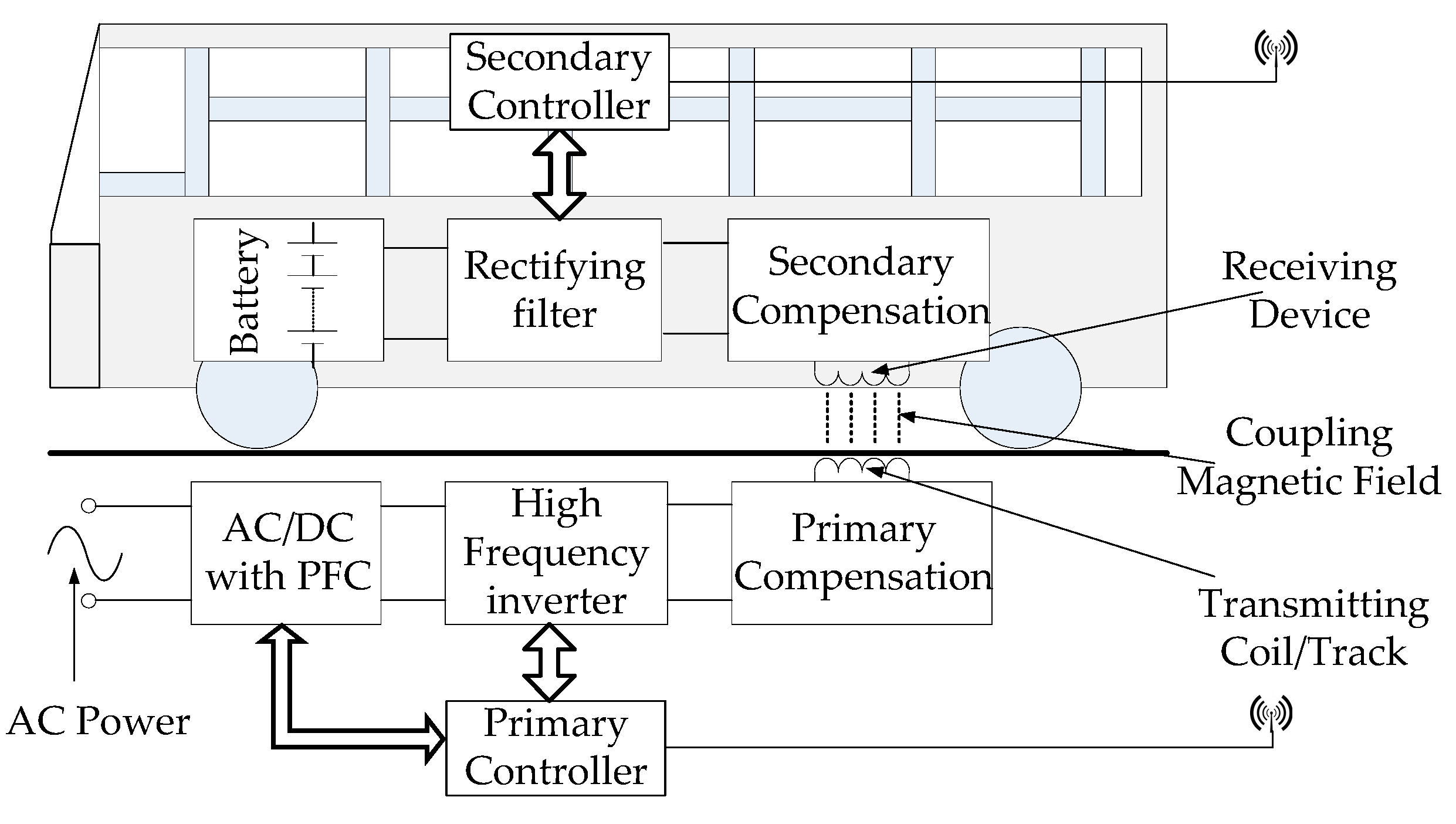
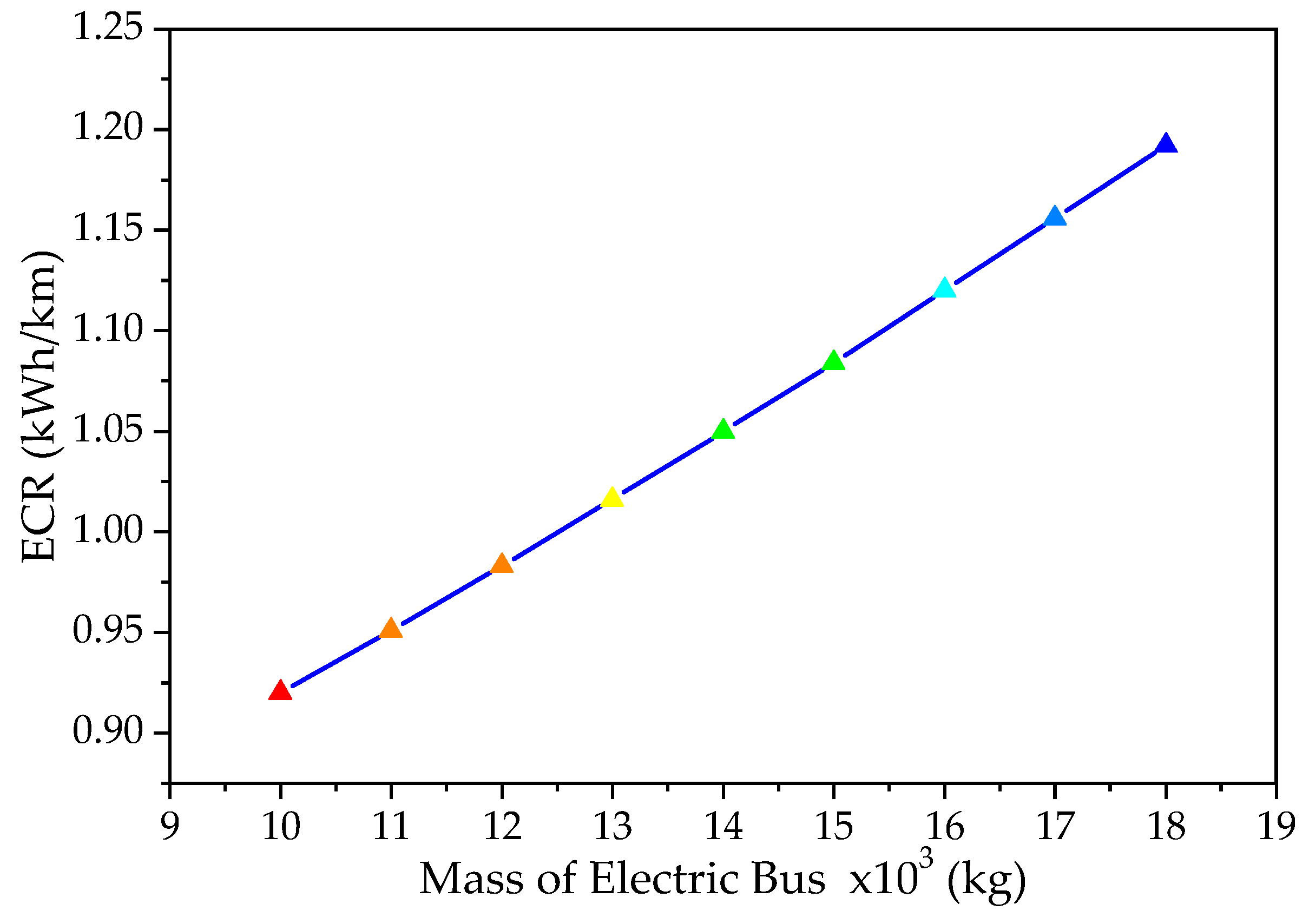
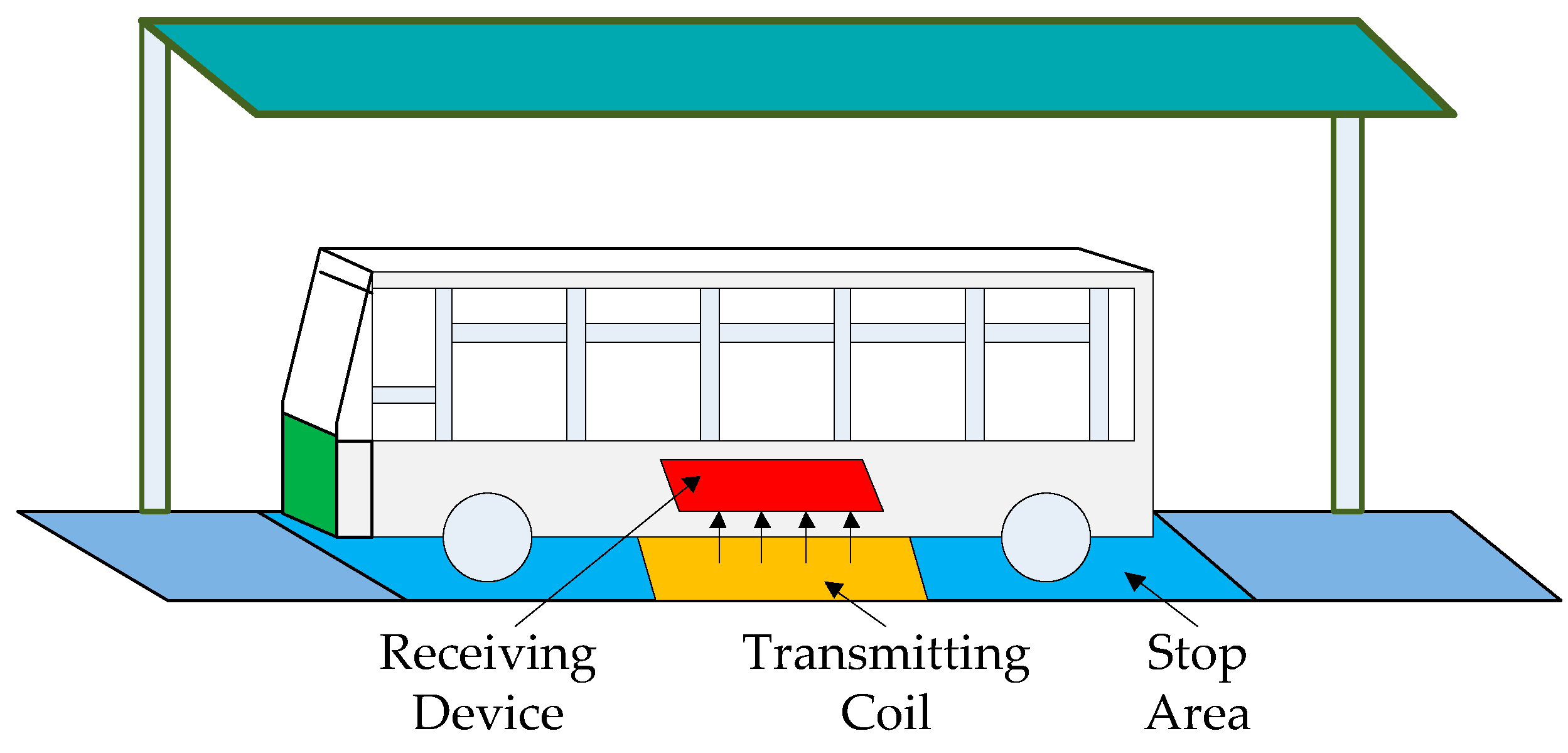

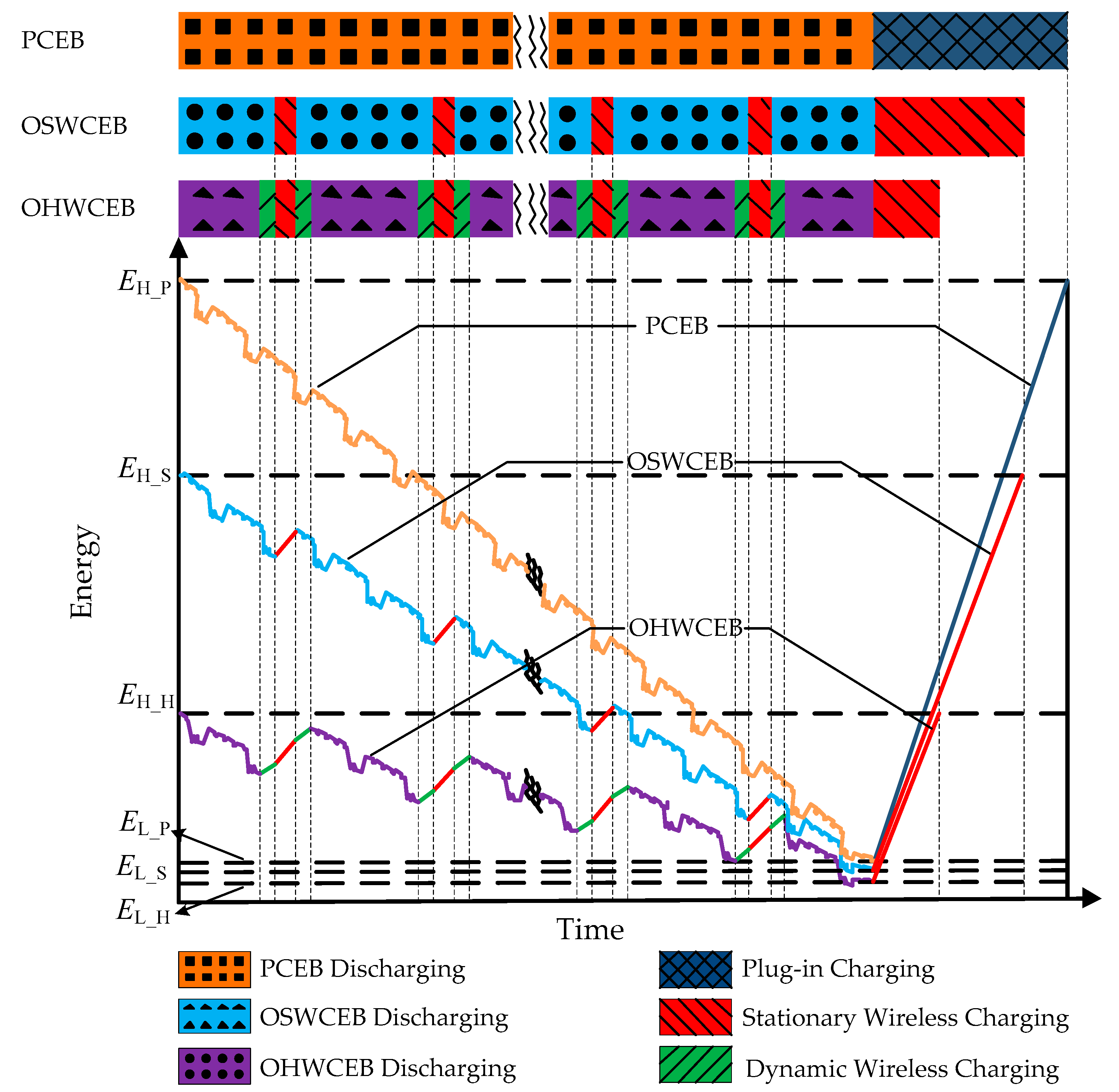


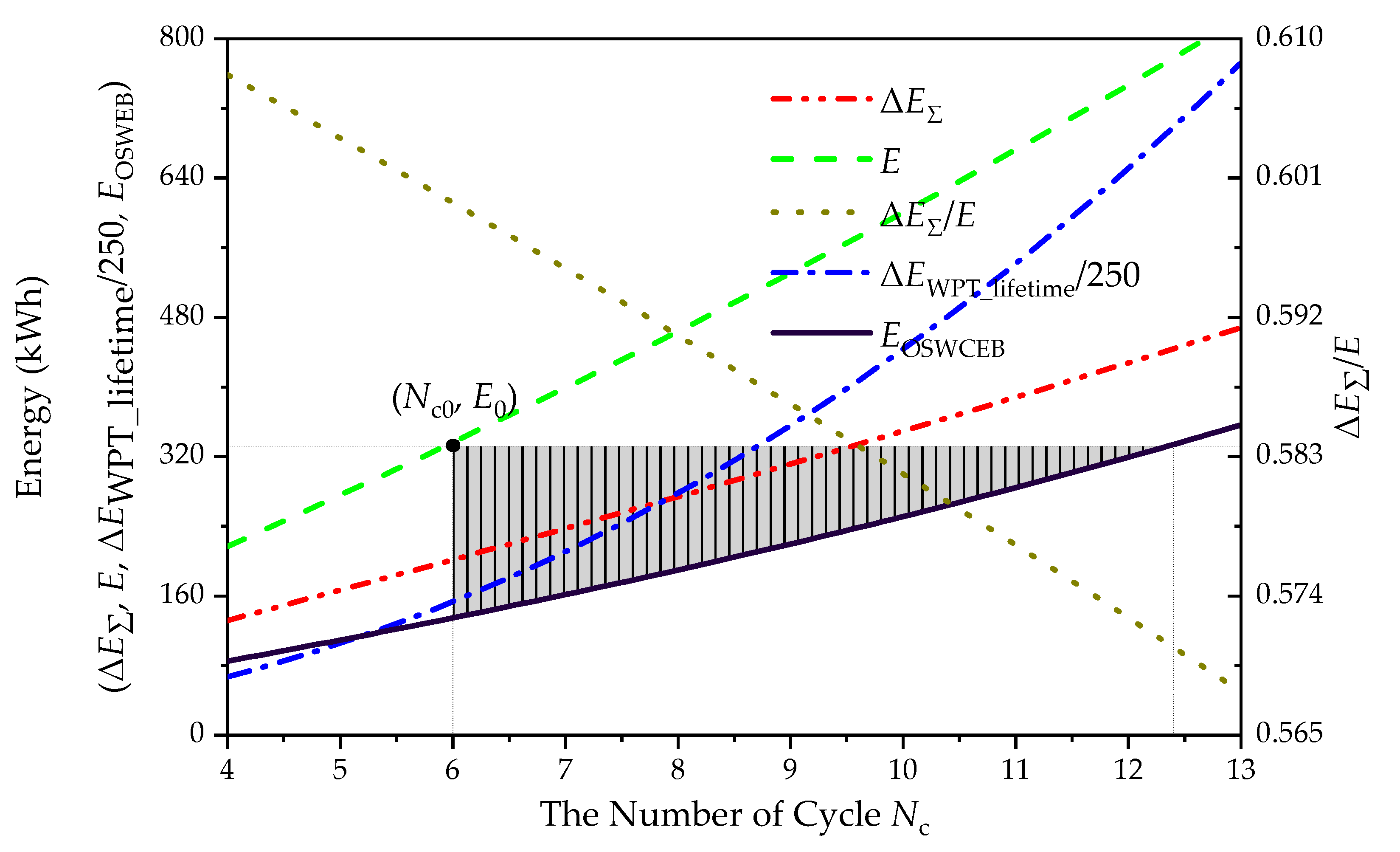
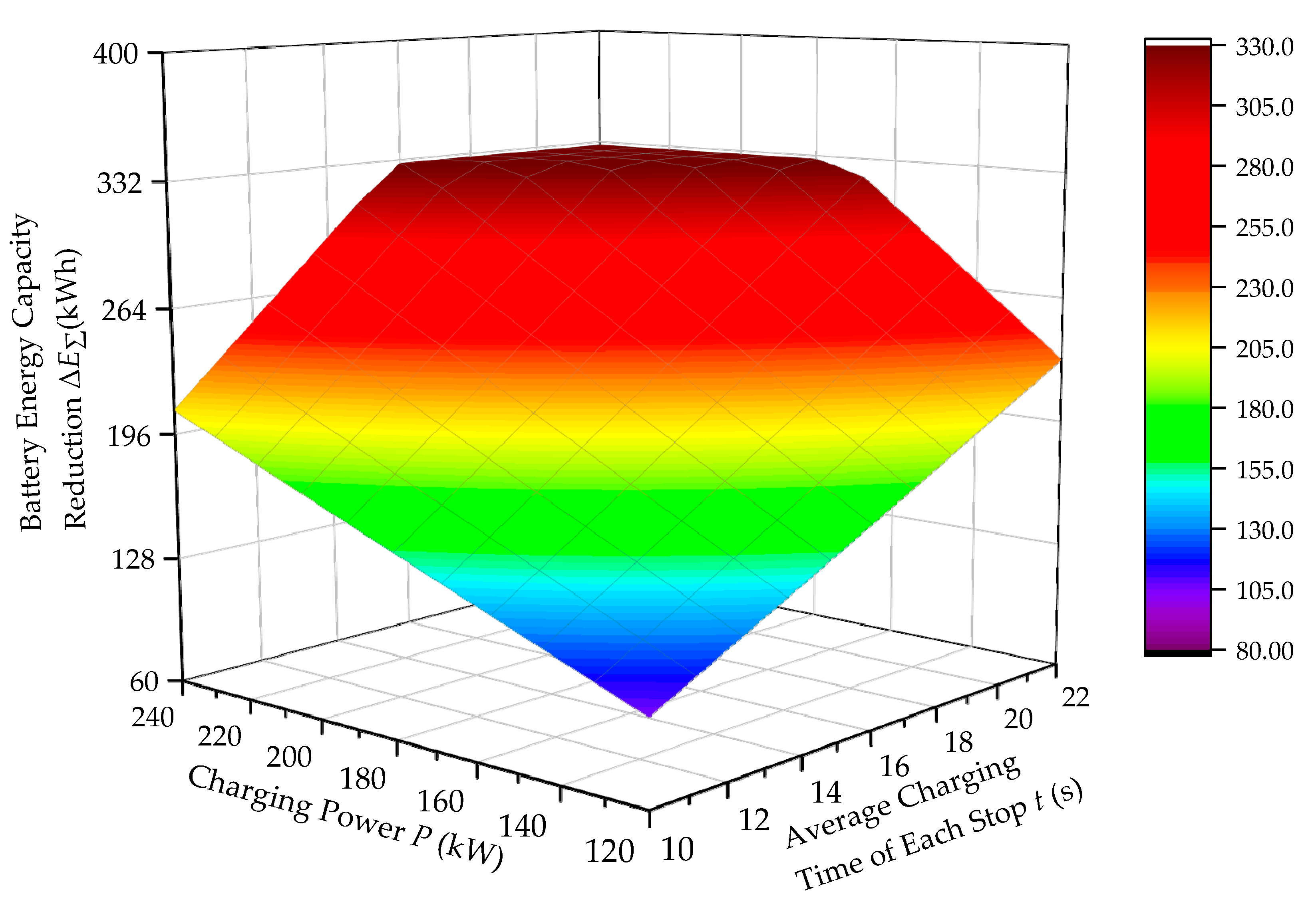
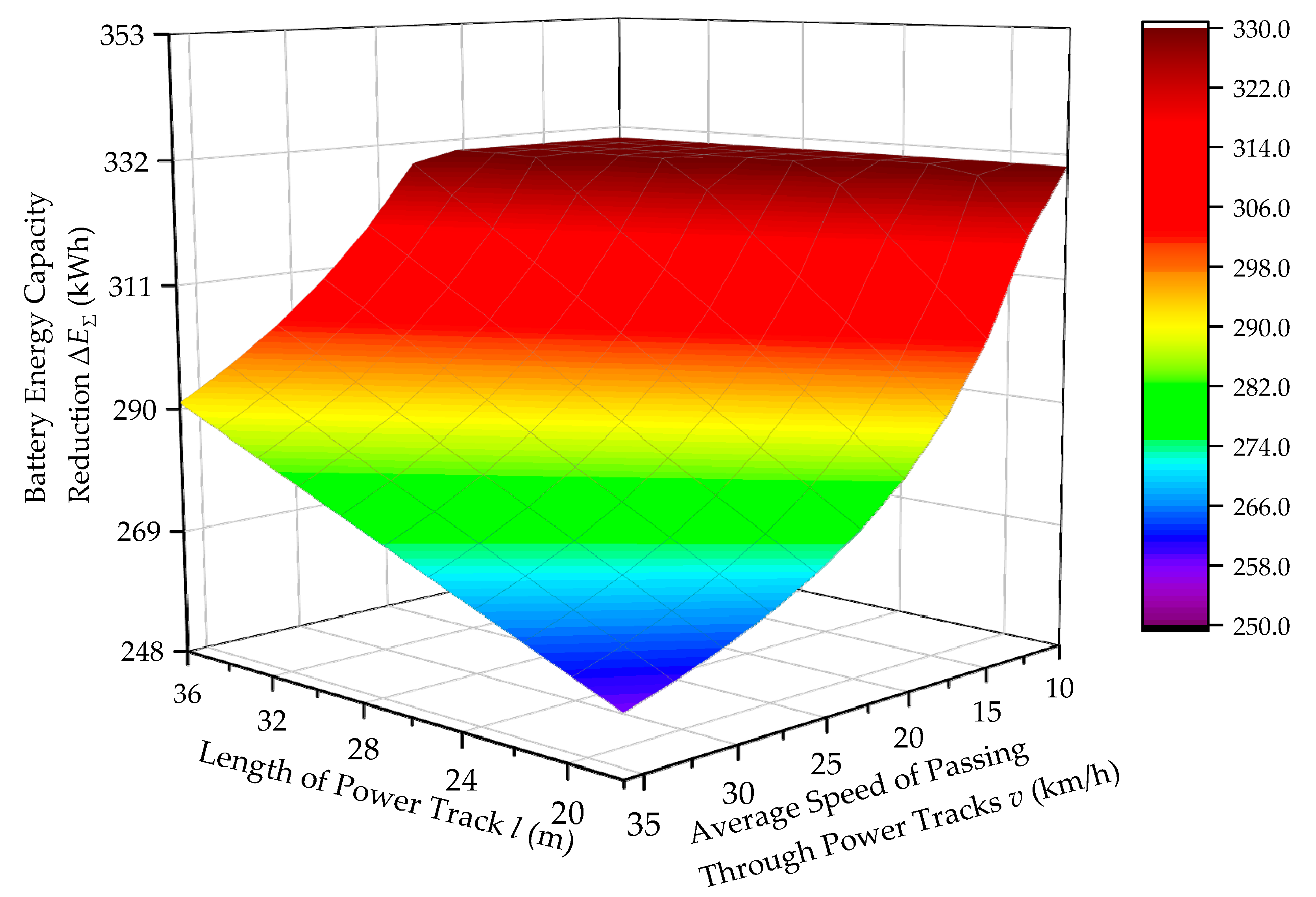
| Notation | Value |
|---|---|
| Mass of the electric bus (kg): MBus0 | 13,900 |
| ECR of the electric bus (kWh/km): b0 | 0.96 |
| Battery energy capacity (kWh): E0 | 332 |
| Mass of the battery pack (kg): M0 | 2768 |
| Battery gravimetric energy density (kWh/kg): α0 | 0.12 |
| Notation | Value |
|---|---|
| Length of the circular route (km): L0 | 35 |
| The number of cycles during a day: Nc0 | 6 |
| The number of stop of the round trip: Ns0 | 52 |
| The output power of the wireless charger (kW): Pout | 200 |
| Average stop time at each stop (s): t0 | 11 |
| Length of the power track installed near each stop (m): l0 | 24 |
| Average speed of the OHWCEB passing through power track in each cycle (km/h): v0 | 20 |
| Efficiency of the stationary wireless-charging system (%): ηs0 | 95 |
| Efficiency of the dynamic wireless-charging system (%): ηd0 | 85 |
| Price of electricity per kilowatt-hour ($/kWh): pe0 | 0.1394 |
| Battery cost per unit of energy capacity ($/kWh): pb0 | 400 |
| Price of per transmitting coil: pcoil0 ($/each) | 60 |
| Price of per set of auxiliary equipment: paux0 ($/each) | 5000 |
| Price of power track per unit meter: ptrack0 ($/m) | 60 |
| The number of electric bus operating on the route: NBus0 | 12 |
| The number of working days of the bus per year (d): Nd0 | 350 |
| Battery life (y): Ny0 | 10 |
| Limit parameter of the battery level: λ0 | 0.6 |
| Notation | Value 1 (OSWCEB) | Value 2 (OHWCEB) |
|---|---|---|
| Battery energy capacity reduction (kWh): ΔEΣ | 201.63 | 304.16 |
| Battery mass reduction (kg): ΔMΣ | 1680.28 | 2534.67 |
| Battery energy capacity reduction contributed by the reduction of ECR (kWh): ΔEECR | 10.97 | 16.54 |
| Production cost saving ($): PCS | 80,653.28 | 121,664.36 |
| Operation cost saving ($): OCS | 5352.26 | 8071.28 |
| Total cost saving ($): TCS | 64,078.87 | 101,828.97 |
© 2019 by the authors. Licensee MDPI, Basel, Switzerland. This article is an open access article distributed under the terms and conditions of the Creative Commons Attribution (CC BY) license (http://creativecommons.org/licenses/by/4.0/).
Share and Cite
Yin, A.; Wu, S.; Li, W.; Hu, J. Analysis of Battery Reduction for an Improved Opportunistic Wireless-Charged Electric Bus. Energies 2019, 12, 2866. https://doi.org/10.3390/en12152866
Yin A, Wu S, Li W, Hu J. Analysis of Battery Reduction for an Improved Opportunistic Wireless-Charged Electric Bus. Energies. 2019; 12(15):2866. https://doi.org/10.3390/en12152866
Chicago/Turabian StyleYin, Andong, Shenchun Wu, Weihan Li, and Jinfang Hu. 2019. "Analysis of Battery Reduction for an Improved Opportunistic Wireless-Charged Electric Bus" Energies 12, no. 15: 2866. https://doi.org/10.3390/en12152866





